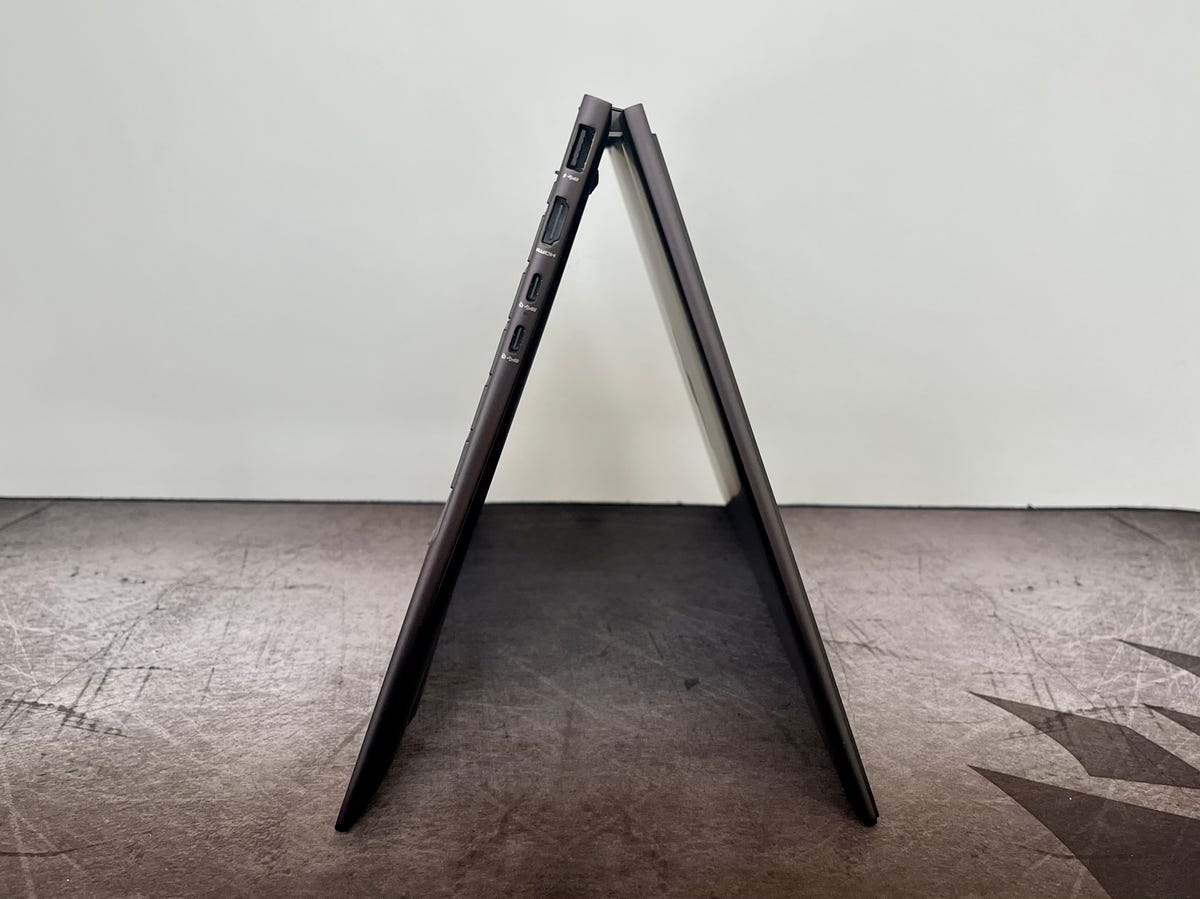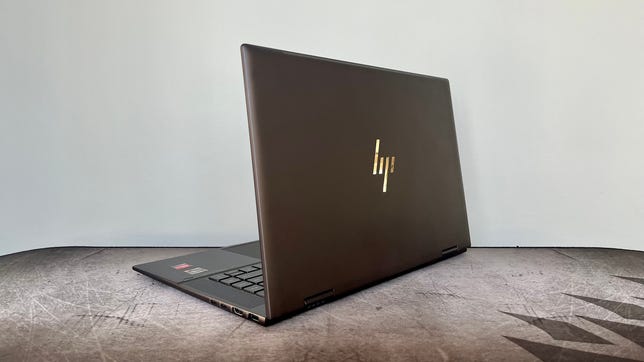HP’s Envy line of laptops and two-in-one convertibles is the middle child between the mainstream Pavilion series and the premium Spectre line. The Envy x360 15 is a 15.6-inch two-in-one that delivers the best of both worlds: a premium design that’s closer to that of a Spectre at a price that’s more meat-and-potatoes Pavilion. The Envy x360 15 boasts an attractive, rigid all-metal body, but the design is no different than last year’s model. And while we don’t mind last year’s looks, we are less enthused with HP sticking with a widescreen 16:9 display when the increasingly popular 16:10 panels found in such convertibles as the Dell Inspiron 16 two-in-one and Lenovo Yoga 7i 16 are roomier and more useful, while hardly adding to the system’s overall footprint.
The Envy x360 15’s component lineup is solidly midrange with a Ryzen 7 5825U CPU that’s now a year old and a generation behind AMD’s current 6000 series. It’s paired with 12GB of RAM that’s more than the 8GB you get with typical budget models but less than the 16GB you can usually find at this price. The biggest change from last year’s model is HP having doubled the webcam resolution from a grainy 720p to a crisp 1440p camera. In the era of video conferences, a bump in webcam fidelity is greatly appreciated. Then again, if the webcam is the headliner, it’s not much of an update overall.
Like
- Premium looks at mainstream price
- 1440p webcam
- Long battery life
Don’t Like
- 16:9 display feels cramped and outdated
- Dim display
HP offers the Envy x360 15 in a host of configurations with both Intel and AMD CPUs. Our test system is available at Best Buy (model 15-ey0023dx) for $1,050 and is regularly discounted to only $750. Best Buy’s sales constantly fluctuate, so if it’s not on sale there, you can find a similar model at HP with 16GB of RAM that lists for $1,130. It’s currently out of stock, but its price was reduced to $930 recently. In the UK, the Envy x360 15 starts at 750, and in Australia it’s AU$1,999.
With its octa-core Ryzen 7 5825U and 12GB of RAM, the Envy x360 offers strong application performance and some capacity for basic photo editing. Its integrated Radeon GPU isn’t as powerful as Intel’s integrated graphics processor, however, and Intel’s isn’t all that powerful to begin with. Content creators will want to look elsewhere. With the efficient Ryzen 7 U-series chip, the system is able to operate in silence the majority of the time. And when the cooling fans are required, they spin quietly. The efficient CPU also allows for long battery life — nearly 12 hours on our battery drain test.
HP Envy x360 15-ey0023dx
| Price as reviewed | $1,050 |
|---|---|
| Display size/resolution | 15.6-inch 1,920×1,080 touch display |
| CPU | 2GHz AMD Ryzen 7 5825U with Radeon Graphics |
| Memory | 12GB DDR4 3,200MHz RAM |
| Graphics | 512MB AMD Radeon Graphics |
| Storage | 512GB PCIe3x4 NVMe M.2 SSD |
| Networking | MediaTek Wi-Fi 6 MT7921 (2×2) and Bluetooth 5.3 wireless card |
| Operating system | Windows 11 Home 22H2 |
Envious looks
The Envy x360 15 features an all-metal chassis in what HP calls Nightfall Black. The matte-black finish has a hint of brown to it and lends a luxurious look similar to that of the Spectre x360 16 — minus the gem-cut edges, gold accents and ports located in the back corners. The Envy x360 15 won’t look out of place in the boardroom or executive suite and also offers a contrast to the common sight of silver aluminum laptops in coffee shops and shared workspaces.
At 4.2 pounds (1.9 kilograms), the Envy x360 15 feels heavier than it should, likely a result of the extra layers needed for the touch display found on all two-in-ones. The 3-pound Lenovo Yoga 7i makes a better option for daily commutes with its 14-inch, 16:10 display. A smaller, lighter two-in-one also has a more natural feel in tablet mode. The Envy x360 15 looks comically tall and narrow when held in portrait mode as a tablet. It’s also too heavy to hold with one hand and tap, swipe or sketch with the other hand. One last note on the Envy x360 15 as a tablet: A pen is not included.
Geekbench 5 (multicore)
Note:
Longer bars indicate better performance
The aluminum chassis offers a firm feel with little to no flex — even on the lid protecting the display. The keyboard deck provides a solid foundation on which to type. The keys themselves are widely spaced, firm and flat. They offer snappy feedback and a pleasant typing experience. I was immediately comfortable typing on the Envy x360 15. The touchpad, too, is excellent. It felt roomy and responsive. Both the keys and touchpad click offer the perfect amount of travel and are quiet when engaged. No loud, clacky keys or touchpad clicks to be heard.
The 15.6-inch, widescreen 16:9 display looks outdated and cramped when you are scrolling through a long document or web page. Microsoft Word, for instance, with its fat menu bar running across the top doesn’t leave as much room as you might like to read the actual document without constantly scrolling. There’s a reason the 16:10 aspect ratio is so popular among laptops. A 16:10 display feels roomier for the simple fact that it is. A 16:9 display may be better for watching movies, but 16:10 is better for everything else.
The other drawback with the display is its dimness. I measured it at 250 nits at maximum brightness. A 250-nit panel is budget territory. I wouldn’t be surprised to see such a display on a lower-end configuration in HP’s mainstream Pavilion line, but I expect better when stepping up to the Envy series. While the matte-black chassis might be worthy of boardroom inclusion, you had better hope your boardroom isn’t drenched in natural sunlight. I had the display dialed up to max brightness in a north-facing room on a cloudy day in winter in northern New England, and there were still times I hit the brightness-up hoping for more.
In contrast to the dim, 16:9 display, the webcam received an upgrade in this year’s model. Gone is the grainy 720p webcam of yore, and in its place is a 5-megapixel camera that can capture 1440p, 30fps video. It produced a crisp, well-balanced picture with accurate color and skin tones. The webcam is also an IR cam, so you can sign in to Windows simply by placing your face in front of the laptop.


The Envy x360 15 offers a strong selection of ports, but you miss out on Thunderbolt 4 support because of the AMD chipset. The two USB-C ports support a display and high-speed data, however, and there’s also an HDMI port for connecting to an external display. With a pair of USB Type-A ports in addition to the USB-C ports, you won’t need to hassle with an adapter to connect your devices. You also get an SD card slot, which is not usually found on a mainstream laptop.
Despite its good looks, stellar webcam and comfortable keyboard, the Envy x360 15 is hard to recommend because of its dim, 16:9 display. If the display isn’t an issue for you, just be sure to wait for a good sale price. Otherwise, a more modern two-in-one with a 16:10 display such as the Dell Inspiron 16 2-in-1 or Lenovo Yoga 7i 16 provides a larger workspace without adding much to the size and weight of the system.
How we test computers
The review process for laptops, desktops, tablets and other computer-like devices consists of two parts: performance testing under controlled conditions in the CNET Labs and extensive hands-on use by our expert reviewers. This includes evaluating a device’s aesthetics, ergonomics and features. A final review verdict is a combination of both objective and subjective judgments.
The list of benchmarking software we use changes over time as the devices we test evolve. The most important core tests we’re currently running on every compatible computer include: Primate Labs Geekbench 5, Cinebench R23, PCMark 10 and 3DMark Wild Life Extreme.
A more detailed description of each benchmark and how we use it can be found in our How We Test Computers page.
Geekbench 5 (multicore)
Note:
Longer bars indicate better performance
Cinebench R23 (multicore)
Note:
Longer bars indicate better performance
PCMark 10 Pro Edition
Note:
Longer bars indicate better performance
3DMark Wild Life Extreme
Note:
Longer bars indicate better performance
Streaming video playback battery drain test (minutes)
Note:
Longer bars indicate better performance
System Configurations
| HP Envy x360 15-ey0023dx | Microsoft Windows 11 Home; 2GHz AMD Ryzen 7 5825U with Radeon Graphics; 12GB DDR4 3,200MHz RAM; 512MB Radeon Graphics; 512GB SSD |
|---|---|
| Lenovo Yoga 7i (14-inch, Gen 7) | Microsoft Windows 11 Home; 1.7Ghz Intel Core i7-1255U; 16GB DDR5 6,400MHz RAM; 128MB Intel Iris Xe Graphics; 512GB SSD |
| Acer Spin 5 (2022) | Microsoft Windows 11 Home; 2.1GHz Intel Core i7-1260P; 16GB DDR5 6,400MHz RAM; 128MB Intel Iris Xe Graphics; 1TB SSD |
| Dell Inspiron 16 2-in-1 (2022) | Microsoft Windows 11 Home; 1.3GHz Intel Core i5-1235U; 8GB DDR4 3,200MHz RAM; 128MB Intel Iris Xe Graphics; 512GB SSD |
| Samsung Galaxy Book 2 Pro 360 | Microsoft Windows 11 Home; 2.1GHz Intel Core i7-1260P; 16GB DDR5 5,200MHz RAM; 128MB Intel Iris Xe Graphics; 1TB SSD |
| HP Spectre x360 14-ef0013dx | Microsoft Windows 11 Pro; 1.7GHz Intel Core i7-1255U; 16GB DDR4 4,266MHz RAM; 128MB Intel Iris Xe Graphics; 1TB SSD |
Best Laptops for 2023
A selection of the best laptops you can buy right now.
- Most universally useful: MacBook Air M2
- Best budget laptop: HP Pavilion Aero 13
- Best Chromebook: Acer Chromebook Spin 714
- Best budget gaming laptop: Dell G15/G16

